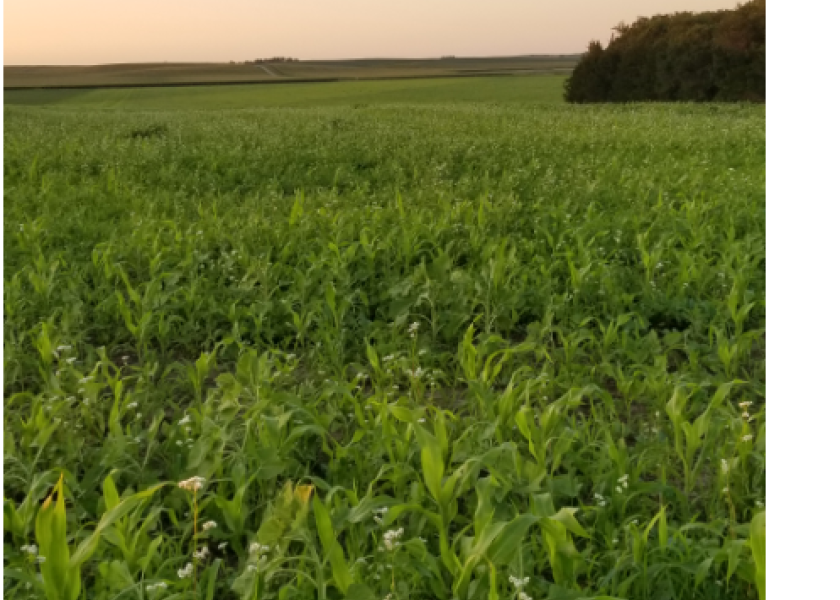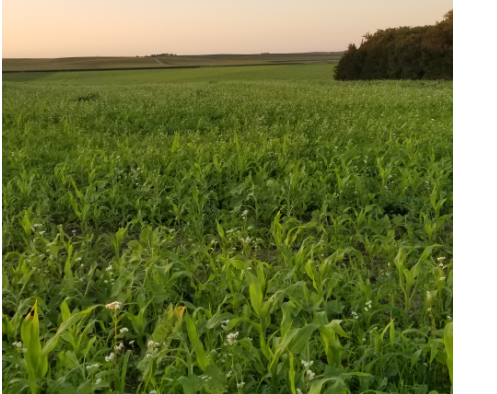My Road to Using Cover Crops

Brian and his wife, Lisa, have three young boys and are based northeast of Plainview, Neb. Brian has farmed with his dad since 2005. They recently introduced regenerative agriculture practices into their operation, focusing particularly on making cover crops successful.
During the winter of 2019, after enduring multiple years of low corn and soybean prices and spending thousands of dollars on fertilizer and chemicals, I decided it was time to try something different. I had been to a couple of cover crop seminars and heard how they might help improve my farming practices and thought I should look into them.
I had four concerns initially:
1. Water infiltration, because I have no irrigation,
2. Fertilizer consumption,
3. Weed control, and
4. Breaking up my corn and soybean monoculture.
After attending some cover crop seminars and watching many videos online of guys who had used cover crops and introduced small grain into their rotation, I decided I wanted to try them for myself. I saw how using cover crops after a small grain could help improve my soils, control weeds and encourage water to actually soak into the ground rather than run off. I had been in a strictly corn and soybean rotation doing tillage passes up to that point. I was also having issues killing weeds with the chemicals we were using. My long-term goal is to reduce fertilizer inputs. For these various reasons, I became interested in changing how I farmed.

I planted oats and peas in late March 2020 in a 60/40 mixture that I then cut and baled in late June. I sold a majority of the hay for profit to help get some income off of those acres.
After that, I planted a seven-way mix of cover crops that I then grazed cattle on this past fall and winter. The seven-way mix was also designed to help provide nitrogen for my 2021 corn crop. After just one year of this practice, my water infiltration was substantially better than where I had just corn and soybeans alone. I definitely saw improvements after one year.

I did purchase a 20-foot John Deere 750 drill to drill the cover crops as well as plant my soybeans in 15-inch rows, no-tilling into cornstalks, something I had not done before. I had always disked stalks twice and hated to see the moisture I was losing by doing that, as well as destroying the soil biology that was trying to work for me underground.
I converted all of my acres to no-till in 2020. This did add some cost to chemicals used to control weeds in the early season, but I eliminated two tillage passes along with the fuel to do those tillage passes. I was very happy with the soybean yields and saw little to no reduction in yield versus previous years.

Things really went pretty smoothly the first year. The only trouble I really had was we got extremely dry in late July which lasted all the way through harvest, really. One downfall on my farm is that I have no irrigation; I am solely dependent on Mother Nature. My seven-way cover crop did well, considering the very low rainfall. While it was pretty short and unable to grow to its full potential, it still provided weeks of cattle grazing.
I also sent in soil samples and had the Haney test done, something I had not done previously. It showed I could cut back some on fertilizer compared to what I had been using. I can't say that I really had much for issues transitioning to using cover crops. I tried to do my "homework" the winter of 2019 to be prepared and knew what I wanted to try.

I did purchase an older 20-foot drill that was set up on 10-inch center row spacing. It had 24 units on it, which was perfect for what I wanted. I slid three rows together to go between two rows of 30-inch corn. I only spent a couple of hours over two afternoons to get it set up the way I wanted.
I'm still very new to all this but am very excited to see where it takes me. It is a leap of faith to try something different, I will say for sure. But I had done a ton of research and knew what I wanted to try. I saw some very encouraging results after only one year, so I'm very hopeful and excited to see how things improve. There is really nothing I would change at this time. I feel it was a pretty smooth transition other than I was nervous to try something different, but with support from my wife and close friends, there was no reason to look back!







